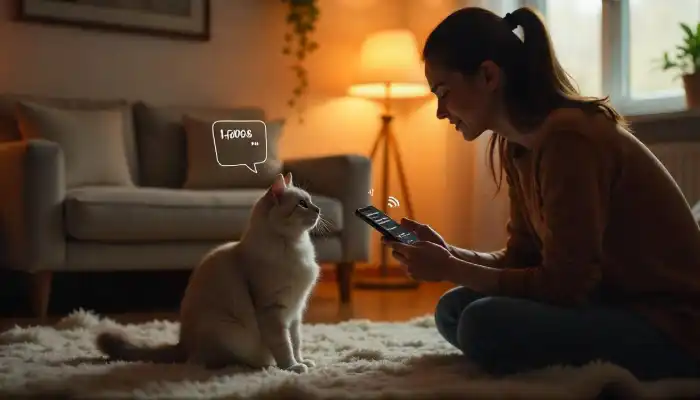How do I say “yes” in cat translator? If you have ever wished to let your feline companion know that the answer is in the affirmative, you aren’t the only one. Cats do not communicate like human beings do. They utilize various body movements, vocal sounds, and actions rather than mere words.
While you can feign an easier solution with a cat translator app, remember that understanding cat communication is necessary to foster a deeper relationship.

How Do Cats Communicate?
Cats communicate using body language, vocalizations, and scent marking rather than words. If you’ve ever wondered, How do I say “yes” in cat translator?, understanding these signals helps build a stronger bond with your feline friend.
Unlike more verbal humans, communication in cats is through:
- Body Language – Emotions are expressed through the position of the tail, eye contact, and ear movement.
- Vocalizations – Different tones like meows, chirps, purrs, and growls communicate diverse things.
- Scent Marking – Rubbing parts of their body like the face against objects or people is a territorial claim.
To know when cats agree with us, we have to interpret their signals since they do not say, “yes” to anything.
Do Cats Understand “Yes”?
How do I say “yes” in cat translator? Cats are likely unable to interpret “yes” like humans do, but they are capable of recognizing positive reinforcement. For example:
- If you offer them a treat and they purr, their association with it is approval.
- When a cat slowly blinks in response to you, it indicates that it trusts you, which can also be interpreted as “yes.”
- If they huddle against your leg and you have previously called them, it indicates that they recognize and accept your interaction.
Recognizing how cats communicate allows for better interaction and trust. Pay attention to their signals to strengthen your connection.
Cat Language for Yes
Curious about how do I say “yes” in cat translator? Cats agree in body language, sounds, and actions—here’s how to understand them!
1. Through Body Language
Your cat uses body language a lot more than anything else. Here is how you can say “yes” to your cat through body language:
- Slow Blink – A prolonged blink is a cat’s way of saying that it trusts you. A cat that returns the blink acknowledges your message.
- Relaxed Posture – When a cat sits or lies down, it also indicates that everything is alright.
- Gentle Nod or Head Tilt – Although this cat behavior is relatively uncommon, some head tilts directed towards them can indicate approval, too.
- Ear Positioning – When a cat interacts with you, turning their ears or head to the front is their way of showing friendship.
All of these gestures are how cats express comfort and acceptance, and will be received the same way when used on a cat.
2. Vocal Cues That Mean “Yes”
Your furry friend can show approval or appreciation using a variety of sounds. If you’ve ever wondered, How do I say “yes” in cat translator?, other people or animals can replicate these sounds and use them as a form of approval as well.
- Soft Chirps (“Mrrp”) – Another cat who shows happiness or a friendly intent is said to do this when meeting another loved one.
- Gentle Repetitive Meows – Gently demanding positive meows from your cat can help reinforce the word “yes.”
- Purring – While cats use this sound for numerous reasons, if it’s used in response to a request, it shows the cat is content with the situation instead of disapproving it.
A good way to reward a friendly meow from your cat is to echo their sound, this reinforces positive actions.
3. Physical Affirmations
While this saying is true for people, the same does not apply to pets. A cat would respond to a gentle caress as a way of accepting their good behavior.
These are some ways your furry friend can appreciate a simple volunteered yes in the form of actions:
- Petting Their Favorite Spot – When purring is accompanied by a gentle push on your hand, your feline is giving a sign of deeply trusting you.
- Offering a Treat – Simple tasks rewarded with treats can ensure your furry friend is pleased hearing the word “yes.”
- Head Bumps or Nose Touches – This gesture is quite common among cats, but better when shown to a baby cat because it builds trust.
Such gestures foster an interaction of bonding between you and your feline.
Communicating with your cat goes beyond words. By using cat-friendly signals, you can strengthen your bond and express agreement naturally!
Comparison: Human “Yes” and Cat “Yes”
Humans say “yes” with words, but cats rely on body language and vocal cues. If you’ve ever wondered, How do I say “yes” in cat translator?, understanding these differences helps strengthen our bond with them.
Since the communication of a cat is different from the communication of a human, comparison is a good way to look at how an agreement is made:
| Saying “Yes” | Simple Blinking |
|---|---|
| Thumb Nodding | Myoboro |
| Smile | Usual Position |
| Thumb Up | Offering Relax |
| Petting Allowance | Head Bumps Mewing |
By knowing these signs, you can convert “yes” into cat-friendly signals with ease.
Is a Cat App Translator Useful?
A cat translator app boasts its ability to interpret cat sounds, but is it reliable?
- What They Do: These apps try to translate the different types of meows into written speech.
- Limitations: These apps rely solely on meows and do not attempt to decipher body language, which is an important form of communication in cats.
- Best Use: They can be useful for children who wish to understand cats, but serious interaction requires commitment.
Adapting to feline behavior, as opposed to depending on an app, will prove more useful.
While humans use words, understanding, how do I say “yes” in cat translator? Involves recognizing blinks, purrs, and gestures. Identifying these signs makes communication more natural and rewarding.
Conclusion
How do I say “yes” in cat translator? Cat translators will lead you in the wrong direction. Devices or apps that claim they understand cats will not give you the required result. Rather, sighting and interacting is the only way. Your cat will appreciate these tried and true techniques. Just don’t expect an immediate answer.
Over time, you will have come to a communication that works with your cat and responds to you, only then will the magic of translation unfold truly!
